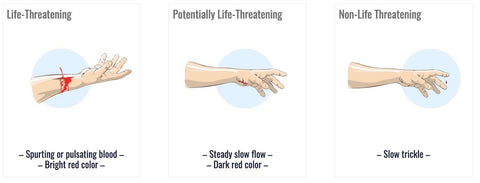One of the leading casues of preventable death is blood loss.
The rise of knife crime in the UK is not something that is isolated to the dodgier parts of London. In fact, the London boroughs of Islington and Newham are the ONLY places that come in the top 10 for UK knife killings with the number one area being Inverclyde, Rochdale and the City of Manchester.

However - London is by far the worst place for knife crime in the UK:

This jump in UK knife crime has increased the awarenes and importance of tourniquets in first aid - The tourniquet is a main pilar of your first aid kit for everyone, regardless of where you live.
Knowing how to use a tourniquet is one of the single most important basic first aid skills you can learn - yet most people are never taught how to do this. Instead training is focused on CPR and simple bleeding control.
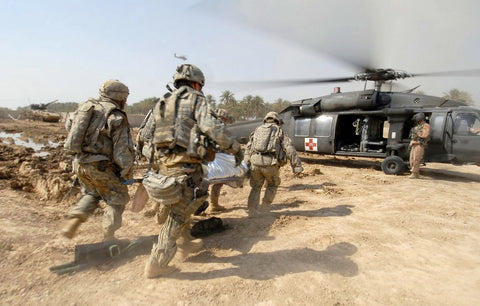
One of the leading causes of preventable death is loss of blood - the best way to stop this is using a tourniquet. One of the reasons why it is not widely used is due to it being wrongly associated with the loss of a limb, and thus should only be used as a last resort. This misunderstanding has led to many deaths due to the lack of training in this critical skill. Having a tourniquet on a limb for ca. 2 hours is very safe and will give minimal problems, however problems can arise from periods over a few hours with 6 hours making muscle tissue irreversably damaged (1).
Types of Tourniquets
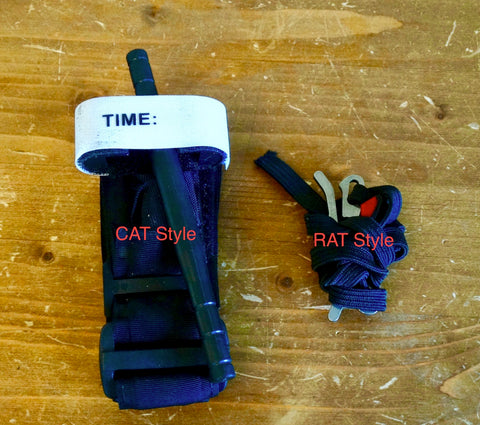
CAT Style tourniquets:
CAT (Combat Application Technique) Tourniquets have a windlass to fully tighten and control the pressure. They can withstand strong forces and the best of them have a windlass made of aluminum.
They are fantastic to keep in the car and at home, or if you are at signifncat risk of trauma, such as a soldier on operations.
Becasue of the windlass and wide strap, they are the gold standard for tourniquets. However they are bulky and thus many people - especially those on in the outdoors - dont carry them.
RATS style tourniquets:
RATS (Rapid Application Tourniquet System) tourniquets are made of a length of strong elastic attached to an aluminum tie off.
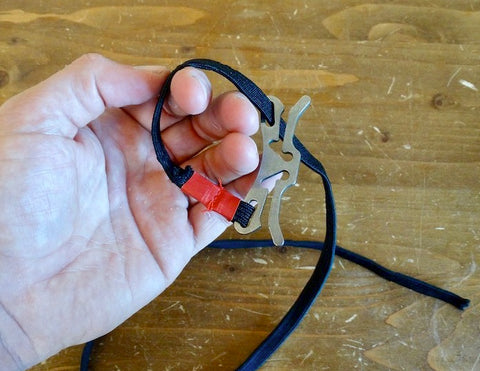
These are not quite as effective as CAT tourniquets, however they are very light, highly portable and very quick and simple to use - even on yourself.
We use a RATS style tourniquet at Limitless Equipment in our Alpha First Aid Kit (LInk to Alpha) because of its portability, small size, and rapid application. At the end of the day, the best tourniquet is the one that you have with you!
When to use a tourniquet
If you have bright blood pulsating or squirting (arterial blood) then you likely need to use a tourniquet.
If the bleeding is dark and slowly bleeding, you need to apply direct pressure on the wound.
How to use a tourniquet
Having a tourniquet applied can be quite painful for the person. Make sure that they understand the reason for this discomfort so they understand whats going on.
First, call the emergancy services, then...
- Remove the clothing so you can apply the tourniquet directly to the skin
- Place the tourniquet at least a few inches above the wound - but NOT on a joint! The best is to apply the tourniquet as far up the limb as possible - for example at the top of the leg or arm, even if the injury is near the hand or lower leg.
- Applying the tourniquet
CAT Tourniquet application:
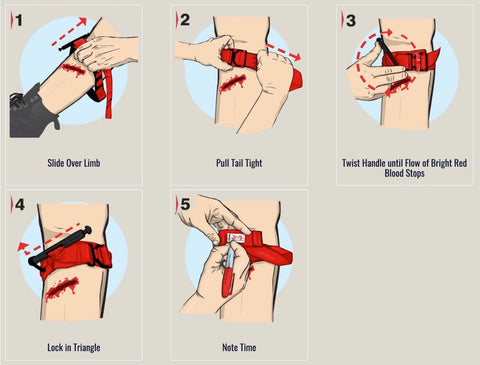
RATS Tourniquet application:
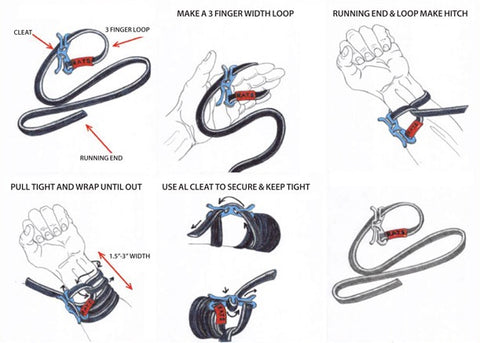
The biggest problem with tourniquets is that they are to loose! (1) If the wound continues to bleed, you may need to move the tourniquet further up the limb and tighten it further.
What if I am alone and need to stop a catastrophic bleed?
This is the worst possible scenario: you could have as little as three minutes to get yourself sorted. In the movies they will improvise a tourniquet from a ripped shirt themselves - this would be highly unlikely to be achievable for someone who has just been stabbed. If you have a proper tourniquet on you have a fighting chance of getting it sorted. Read on for tips on how to improvise one if the worst happens.
Improvising a tourniquet:
The best tourniquets have a windlass - a winding handle to ratchet up the pressure. You can use a belt to help apply direct pressure on a wound, but a proper tourniquet is far far more effective. The best DIY option is to use a tie, triangular bandage or shoulder strap from a bag as these are less stiff than a leather belt - broader material is superior to narrow material. If you do it right improved tourniquets have been shown to be just as effective as the manufactured ones.(3)
(Steps 1-4 below are from the fantastic realfirstaid.co.uk )
1) Position the material apx 5 cm / 2 inches above the injury

2) Tie the material tightly around the limb

3) Insert something rigid under the tourniquet and next to the knot such as a pen. DO NOT place it into the knot you have just tied. This will act as a windlass to tighten the tourniquet until bleeding has stopped.
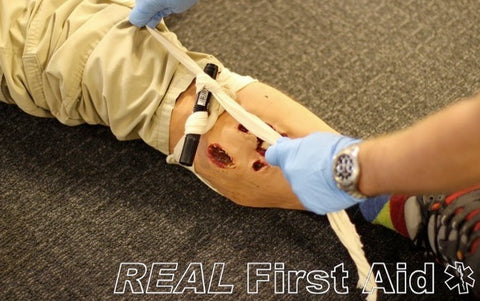
4) Use the free ends of the knot to tie off the windlass, keeping it secure and tight.
Conclusion
While you probably don't need to carry an Abdominal Aortic Tourniquet, if you are driving a car, or involved in any outdoor activity - you really should be carrying a tourniquet as a basic part of any first aid kit.
We don't know of any mainstream company in the UK and Europe that makes first aid kits for the outdoors that include a tourniquet in their kits. It is not recommended as part of the UK MLTB first Aid kits for leading groups in the mountains, almost no mountain guides cary them (despite rockfall being a major cause of accidents when alpine climbing). Children and their wards are not taught to use them on Duke of Edinburgh award related first aid programs. The inclusion of tourniquets is also practically non existent in workplace, home and car first aid kits.
This is an extraordinary oversight as it is a leading cause of preventable death. (4).
Get yourself a tourniquet - they are cheap, last a long time - at a minimum get one to keep in your car if there is an accident. Spend a little time learning how to use it - it is not rocket science.
Whilst we don't make windlass tourniquets at Limitless Equipment, we do sell RATS style tourniquets and they are included in our Alpha First Aid kits as standard. We carry these tourniquets with us on all our outdoor adventures as they are small, compact and light and can be used on kids (and dogs!) easily - they are also faster to apply than windlass based tourniquets. However, windlass tourniquets are the gold standard and we keep them in the car as well as our home. You should do the same.
----------
REFERENCES
(1) Lakstein D, Blumenfield A, Sokolov T, et al. (2003) "Tourniquets for hemorrhage control on the battlefield: a 4 year accumulated experience." Journal of Trauma. 54(5 Suppl):S221–5
(2) Royal College of Surgeons of Edinburgh, Faculty of Pre Hospital Care (2015) “Position statement on the application of Tourniquets”.
(3) Stewart SK, Duchesne JC, Kahn MA(2015) "Improvised tourniquets: Obsolete or obligatory?" Journal of Trauma and Acute Care Surgery. (78)1; 178-183
(4) Evans JA, van Wessem KJ, McDougall D, et al. Epidemiology of traumatic deaths: Comprehensive population-based assessment. World J Surg. 2010;34(1):158–163.
FURTHER READING:
The Royal College of Surgeons Faculty of Pre-Hospital Care Position statement on the application of Tourniquets
TRAINING:
Real First Aid: www.realfirstaid.co.uk
PRODUCT RECOMMENDATIONS:
CAT Style Tourniquet (UK supply) : http://bit.ly/catsukamz
CAT Style Tourniquet (USA supply): http://bit.ly/catsusaamz
Alpha First Aid Kit (UK / Europe only): (coming soon)


